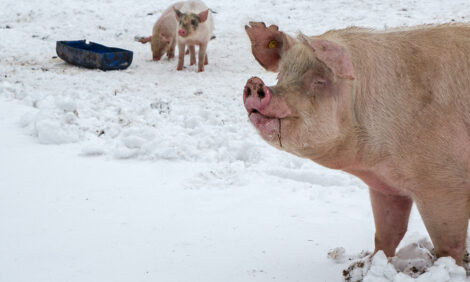



National Pork Board: global update on African swine fever
Dave Pyburn, National Pork Board Chief Veterinarian, shares a global update on ASF with The Pig Site's Sarah Mikesell.“When you look back over time, about 40 of those countries have broken within the last five years, so this has really blown up on us in the last five years,” said Dave Pyburn, chief veterinarian with the National Pork Board.
With China’s outbreak in August 2018, the ASF focus has been there and the virus’ subsequent movement. However, Pyburn said ASF will be an industry issue for the long term, so increasing biosecurity throughout the value chain and monitoring global movement of the virus are critical.
Asia update
“In Asia right now, there are fewer reports out of China as far as outbreaks, but I think that's just fewer reports. From what I'm hearing from veterinarians who travel into the country or work in the country, there's still a lot of virus around, and outbreaks are still occurring,” he noted. “They are still attempting to do repopulations on farms which have not been successful for the most part, so they're breaking again when they put animals back onto the farm.”
Dr Pyburn’s concern right now is that as we move into the 2020 Chinese Lunar New Year, which starts 25 January, Chinese families will begin celebrating by pulling pork back out of their freezers. ASF virus can survive in frozen pork, and after families have eaten, leftover scraps are often fed to backyard pigs which can restart the cycle of disease in China.
“The other thing we're hearing about China is that criminal elements are using drone technology to drop infected material on farms,” Dr Pyburn said. “What happens is the pigs start to break with a disease and the farmers panic. Then the criminal elements come back, buy the pigs cheap because they're getting sick, and sell them on the market to make money. It's just unbelievable, the ways that we're seeing ASF spread in China right now.”
Recently, Chinese pig prices have bounced significantly higher – in some areas they are more than double what the market saw even a few months ago.
“[China’s] prices are incredible right now and that's what is driving this criminal element to move the ASF virus into these pigs. It’s all so they can sell them for a high price,” said Dr Pyburn.
In December, Indonesia was declared positive. So that's the newest country to be hit. Why is that important? It's very important to Australia because there's a lot of Australians that vacation and tour in Indonesia then return home. The concern is that Australians will bring meat products back into Australia and potentially cause an outbreak there.
Pyburn says Vietnam seems to be settling down a bit. The US-based Swine Health Information Center (SHIC) has a project going on in Vietnam, looking at diagnostics and management on-farm. Because every province in Vietnam is positive and it’s been there for a while, it could mean they are “running out of pigs to infect to some degree” said Dr Pyburn.
It has been reported that Vietnam has lost one-quarter of their pigs.
“When you look at China, the estimate - a conservative estimate right now - is they've lost a half of their pigs since the outbreak began, so that’s a lot of pigs lost to this disease,” Dr Pyburn said.
North and South Korea are also ASF-positive and they are still finding positive feral swine in the DMZ zone along the border, but they are not finding virus much beyond that.
European update
In Europe, Poland now has an outbreak zone to the west of Poland that’s entirely feral swine.
“They found about 100 feral swine so far there that are positive, but the big message here is that it's about 13 miles from Germany, and Germany is basically Iowa for Europe, as far as where the pigs go to finish,” he explained. “It would be a big deal if [ASF] moved over the border. Germany is building a fence to keep out those feral swine. Germany and Poland are both organising hunts in the area to try to depopulate feral swine.”
In an effort to physically keep feral pigs from crossing borders, Germany has built an electric fence, while Denmark has already erected a woven wire fence.
Outbreaks continue to be reported in Bulgaria and Belgium. The Belgium outbreaks are feral pigs and appear confined to the country's forests. However, the outbreaks are moving closer to the French border, which is also concerning for western Europe.
Protecting US borders
A few weeks ago, the NPB Board of Directors got a behind the scenes look at US Customs and Border Protection at Miami International Airport. The airport has more than 190,000 international flights and 21.9 million international passengers moving through the port annually.
The NPB group got to see the Beagle Brigade in action. While the Customs and Border Protection team was working a flight, they caught three suspicious bags while the NPB group watched. The Board also was able to speak to inspectors.
“The most telling thing for me from that visit was afterwards, one of the members of our Board, who can be sceptical at times, came to me and said ‘Going in - I would say on a scale of one to 10 - I was about at a two or three as far as confidence in Customs and Border Protection in finding this material. I'm coming away a seven or eight after this interview’," said Dr. Pyburn.
Despite the confidence in US Customs and Border Protection, Dr Pyburn stressed that is only one part of biosecurity in the US. Producers need to be especially vigilant on-farm.
“As producers in the industry, we all have a job to do, and we've got to take care of our own biosecurity at home,” he concluded.









